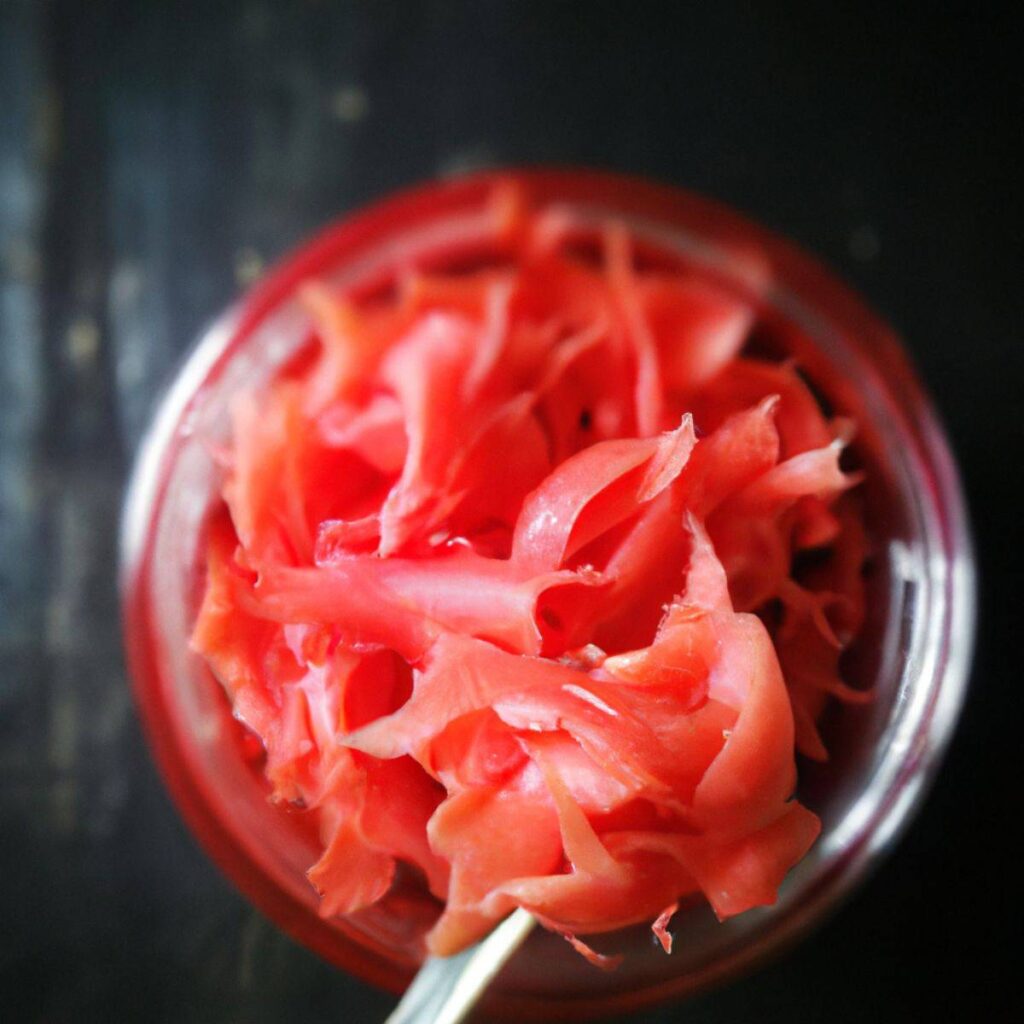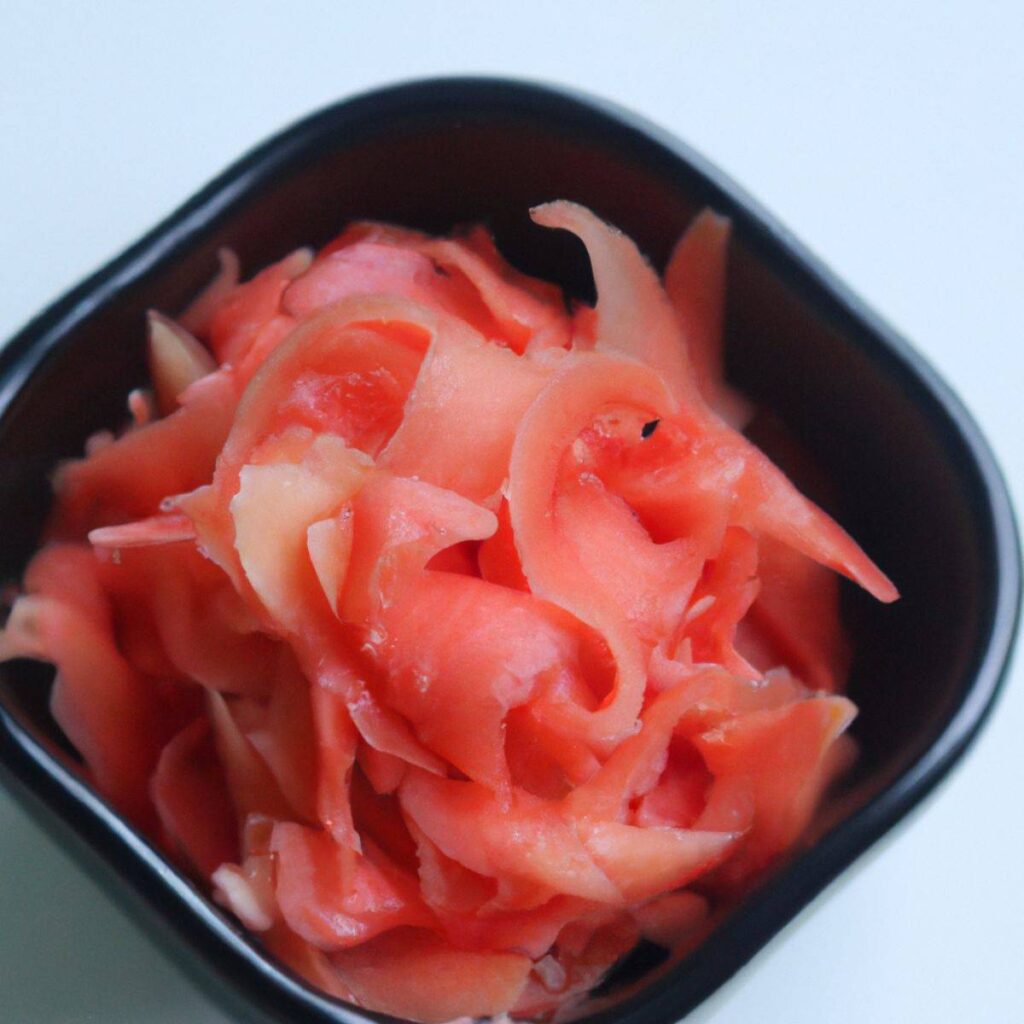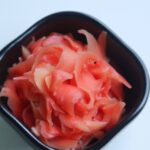There’s something undeniably enchanting about the simplicity and vibrancy of Beni Shoga, or red pickled ginger. This Japanese staple, often seen adorning the edges of a bento box or nestled beside a warm bowl of ramen, is more than just a garnish. It’s a burst of tangy, refreshing flavor that cleanses the palate and enhances the overall dining experience. In my kitchen, Beni Shoga has transformed from a mere condiment to a must-have, bringing a touch of authenticity to every Asian-inspired meal.
Now, imagine creating this delightful pickled ginger right in your own kitchen. The process is surprisingly straightforward, requiring just three ingredients and a bit of patience. The result? A homemade Beni Shoga that’s far superior to any store-bought version. Its vibrant hue and zesty flavor are not just a treat for the taste buds but also a feast for the eyes. So, let’s embark on this culinary adventure together. Scroll down to discover how you can bring this traditional Japanese flavor into your home with ease and flair.

What You’ll Need for This Recipe
Before we dive into the magical world of making Beni Shoga, let’s gather our culinary warriors. This recipe is beautifully simple, requiring only a trio of ingredients. Each plays a pivotal role in creating that perfect harmony of flavors. So, let’s break them down, shall we?
Ginger (100 grams, peeled): The star of the show! Fresh ginger brings a sharp, spicy kick that’s both invigorating and essential. For Beni Shoga, young ginger is preferred for its tender texture and milder taste. If you can’t find young ginger, regular ginger will work just fine. Just ensure it’s fresh and firm to the touch, with a smooth, shiny skin.
Water (300 ml): The unsung hero. Water is crucial for blanching the ginger, softening its fibrous texture and mellowing its pungency. It’s a simple step, but it makes all the difference. Use filtered water for the best results, ensuring a clean, pure flavor.
Plum Vinegar (50 ml): This is where the magic happens. Plum vinegar, also known as Umeboshi vinegar, imparts a unique tangy-sweet flavor and the signature pink hue to the ginger. It’s a staple in Japanese cooking, known for its health benefits and distinctive taste. If you’re unable to find plum vinegar, apple cider vinegar with a pinch of sugar can be a good substitute, though the flavor profile will slightly differ.
How to Make Beni Shoga
Now, let’s roll up our sleeves and embark on the culinary journey of creating Beni Shoga. It’s a process filled with little moments of joy, from the sizzle of ginger hitting the water to the final, satisfying glimpse of the vibrant pink ginger. Here’s how we’ll do it:
Boil the Water: Start by bringing a small pot of water to a rolling boil. This step is crucial for softening the ginger, ensuring it absorbs the vinegar beautifully.
Blanch the Ginger: Once the water is boiling, add your peeled ginger. Let it dance in the boiling water for a brief 30 seconds. This blanching process is key to reducing the ginger’s sharpness, making it just right.
Cool and Dry: After its quick bath, fish out the ginger and let it cool on a paper towel. Patience is key here. Let it dry completely. This ensures the vinegar coats it evenly later.
Vinegar Bath: Now, for the transformative step. Place the ginger in a container and lovingly pour the plum vinegar over it. Make sure the ginger is fully submerged in this tangy elixir. This is where the ginger gets its signature tang and color.
Marinate: Let the ginger sit in its vinegar spa for at least 3 hours. This marination time allows the flavors to meld and the ginger to soak up all the goodness of the vinegar.
Refrigerate: Finally, tuck your Beni Shoga into the fridge. It’s a waiting game, but oh, so worth it. This ginger can be a trusty companion in your culinary adventures for up to a year.
What We Love About This Recipe
There’s so much to adore about this Beni Shoga recipe, it’s hard to know where to start. First off, its simplicity is utterly charming. With just three ingredients, this recipe demystifies the art of Japanese pickling. It’s approachable, doable, and oh-so-rewarding. For those of us who are often intimidated by complex recipes, this one is a breath of fresh culinary air.
Then, there’s the transformation of the ginger. It’s nothing short of magical. Watching the pale, sharp slices mellow into soft, tangy morsels is a delight. The ginger loses its aggressive edge and gains a gentle, nuanced flavor. It’s a beautiful reminder of how simple ingredients can evolve into something extraordinary.
The versatility of Beni Shoga also deserves a shoutout. It’s not just a garnish; it’s a flavor enhancer. Whether it’s perched atop a sushi roll, nestled beside a steaming bowl of ramen, or simply used to add a zing to a salad, it brings a pop of color and flavor. It’s the kind of recipe that keeps on giving, brightening up meal after meal.
Lastly, let’s talk about the satisfaction of making something from scratch. There’s a certain pride that comes from creating a staple of Japanese cuisine in your own kitchen. It connects you to a culture and a tradition, all while providing a delicious, homemade condiment. This Beni Shoga recipe isn’t just about the end product; it’s about the joy of the journey. The journey from simple ingredients to a jar full of zesty, pickled perfection. Similarly, the Ham and Asparagus Quiche recipe embodies the spirit of homemade culinary delights, offering a perfect pairing for a brunch where Beni Shoga could be a star side.
Recipe Variations for Beni Shoga
While the classic Beni Shoga recipe is a gem in its own right, there’s always room for a little creativity in the kitchen. Here are some fun twists to put your own spin on this traditional Japanese condiment:
Apple Cider Vinegar Substitute: If plum vinegar is hard to come by, apple cider vinegar can be a great alternative. It adds a different kind of tanginess and a hint of apple flavor. Just add a pinch of sugar to balance the tartness.
Spice It Up: For those who love a bit of heat, adding a few slices of red chili to the vinegar can give your Beni Shoga an exciting spicy kick. It’s a simple addition that can elevate the flavor profile. This variation would pair wonderfully with the Italian Grinder Pasta Salad, complementing its rich and hearty ingredients.
Lemon Zest Infusion: Infuse the vinegar with a bit of lemon zest for a citrusy twist. This adds a refreshing aroma and a subtle lemony flavor, making the ginger even more invigorating.
Sweetened Variation: Some palates prefer a touch of sweetness. Dissolve a small amount of sugar in the vinegar before adding the ginger. This creates a sweet-and-sour version that’s absolutely delightful.
Herbal Notes: Adding a few sprigs of fresh herbs like thyme or rosemary to the vinegar can introduce an aromatic quality to the Beni Shoga. It’s a subtle change that brings a whole new dimension.

Pairing and Serving Suggestions for Beni Shoga
Beni Shoga isn’t just a pretty face on the plate; it’s a versatile player in the culinary game. Here are some fabulous ways to pair and serve this zesty condiment, elevating your dishes from good to unforgettable:
With Sushi and Sashimi: It’s classic for a reason. The sharp tang of Beni Shoga cuts through the richness of raw fish, balancing each bite. Trader Joe’s Pasta Salad, with its unique blend of flavors, could also benefit from a touch of this zesty condiment, adding an unexpected twist to the dish.
Ramen’s Best Friend: Drop a few slices into your steaming bowl of ramen. It adds a refreshing contrast to the savory broth.
Topping for Donburi: Whether it’s a hearty bowl of Gyudon or Katsudon, a sprinkle of Beni Shoga brings a welcome zing.
Side for Grilled Meats: Pair it with Yakitori or grilled fish. The ginger’s acidity is perfect for cutting through the fat.
In a Bento Box: Add a small portion to your bento for a palate-cleansing effect between different flavors.
As a Salad Zest: Toss it into Asian-style salads. It’s a game-changer for simple greens.
Refreshment in Drinks: Yes, you read that right. Add a slice to a cold glass of water or a cocktail for a subtle gingery twist.
Onigiri Accent: Insert a slice into your homemade Onigiri (rice balls) for a surprise burst of flavor.
FAQ – Beni Shoga
Sure, you can! Regular vinegar works, but it won’t give you the same flavor or color. For a closer match, try apple cider vinegar with a pinch of sugar.
When stored properly in the fridge, it can last up to a year. Just make sure it’s fully submerged in vinegar in an airtight container.
Yes, peeling is key. It helps the ginger absorb the vinegar better and gives a smoother texture.
Absolutely! The traditional recipe doesn’t include sugar. Any sweetness usually comes from the plum vinegar.
Thin slices are the way to go. They pick up the vinegar’s flavor more effectively and have a pleasant, delicate texture.
Freezing isn’t recommended. It can alter the texture and flavor. Refrigeration is your best bet for keeping it fresh.

Beni Shoga
- Total Time: 3 hours 11 minutes (including marinating time)
- Yield: 1 serving 1x
Description
Discover the art of making Beni Shoga, a traditional Japanese red pickled ginger. This simple recipe transforms fresh ginger into a tangy, vibrant condiment that’s perfect for enhancing a variety of dishes. Learn how to create this authentic Japanese garnish at home with just a few ingredients.
Ingredients
- 100 grams Ginger, peeled
- 300 ml Water
- 50 ml Plum Vinegar
Instructions
- Bring a small pot of water to a boil.
- Add the ginger and cook for 30 seconds.
- Remove the ginger and let it cool on a paper towel.
- Place the ginger in a container and cover with plum vinegar.
- Let it marinate for at least 3 hours.
- Store in the refrigerator for up to a year.
Notes
Young ginger is preferred for its milder flavor and tender texture.
If plum vinegar is unavailable, apple cider vinegar with a pinch of sugar can be used as a substitute.
The pickled ginger can be used as a garnish or flavor enhancer in various dishes.
- Prep Time: 10 minutes
- Cook Time: 1 minute
- Category: Condiment
- Method: Pickling
- Cuisine: Japanese
Nutrition
- Serving Size: 100 g
- Calories: 100 kcal
- Sugar: 2 g
- Sodium: 0,01 g
- Fat: 1 g
- Saturated Fat: 1 g
- Unsaturated Fat: 1 g
- Trans Fat: 0 g
- Carbohydrates: 18 g
- Fiber: 2 g
- Protein: 2 g
- Cholesterol: 0 mg
Keywords: Beni Shoga, Red Pickled Ginger, Japanese Condiment, Pickling Recipe, Ginger Recipe
